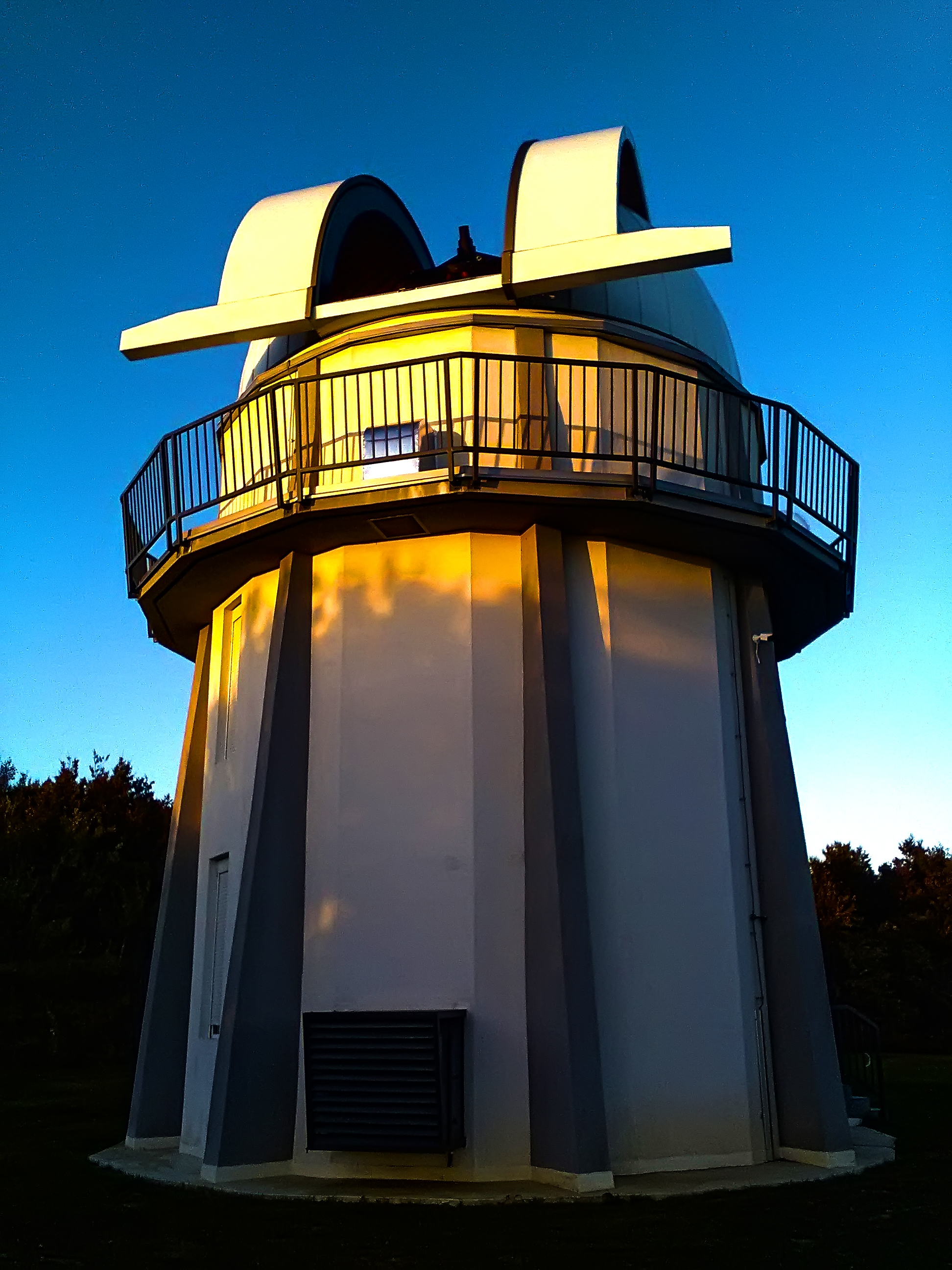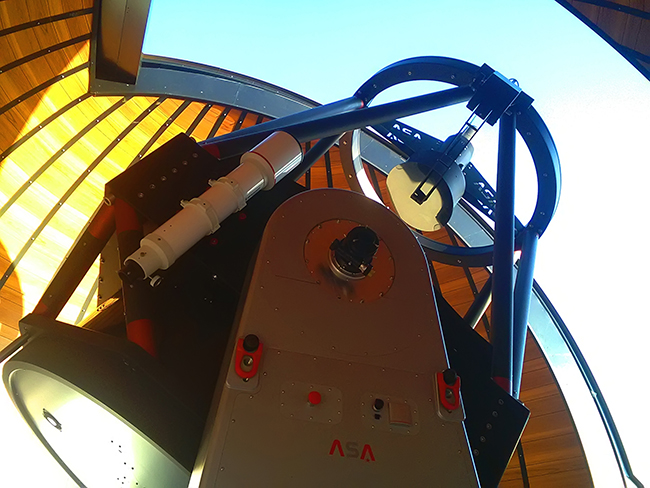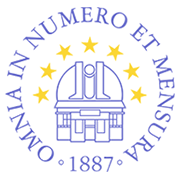Our observing station (vidojevica.aob.rs) is located on the Vidojevica mountain near Prokuplje, at an altitude of 1155m. In the period from 2005 to the present day, five facilities were built, a living facility and four observation pavilions, the infrastructure were completed and a wireless Internet connection was introduced. The living facility can accommodate up to 10 people, and it also has a large meeting hall. This facility is fully equipped for the stay of astronomers and other participants. The station is constantly staffed by technical staff, thanks to which all the equipment is kept in perfect condition, and internet communication with the telescopes is unhindered. Observations on ASV are carried out cycles of 21 days (having a break during the full moon), with the plan to fully extend this period by providing more technical operators.
Vidojevica is one of the few mountains in Serbia with a truly dark sky, where light pollution is minimal. The collected astrometeorological data indicate that Vidojevica is a very suitable area in Serbia for astronomical observations. We installed a weather station with an all-sky camera at ASV. This equipment is automated and continuously collects astrometeorological data (temperature, air humidity, atmospheric transparency, etc.) from this location. The obtained data will help experts from the Observatory when choosing other telescopes, accompanying equipment and instruments.
A large number of solar panels and two medium capacity wind generators are being installed at ASV in order to obtain energy from renewable sources. This equipment was financed by the Government of the Republic of Serbia.
Vidojevica is one of the few mountains in Serbia with a truly dark sky, where light pollution is minimal. The collected astrometeorological data indicate that Vidojevica is a very suitable area in Serbia for astronomical observations. We installed a weather station with an all-sky camera at ASV. This equipment is automated and continuously collects astrometeorological data (temperature, air humidity, atmospheric transparency, etc.) from this location. The obtained data will help experts from the Observatory when choosing other telescopes, accompanying equipment and instruments.
A large number of solar panels and two medium capacity wind generators are being installed at ASV in order to obtain energy from renewable sources. This equipment was financed by the Government of the Republic of Serbia.
Station coordinates:
Longitude: 21° 33' 20.4"
Latitude: 43° 08' 24.6"
Elevation: 1155m
Longitude: 21° 33' 20.4"
Latitude: 43° 08' 24.6"
Elevation: 1155m


1.4 m telescope "Milutin Milanković"
The robotic telescope "Milutin Milanković" is the most ambitious project implemented under the auspices of the Observatory. It was named in honor of one of our most prominent astronomers and scientists, Milutin Milanković. The observatory is proud to point out that in 1951 Milanković served as director.
The telescope weighing 8.5 tons was constructed by the Austrian company ASA Astrosysteme. The telescope is located on the third floor of the 12.7 m high pavilion, with an automated movable 7 m dome designed and built by the Italian company Gambato. The "Milutin Milanković" telescope is of the Ritchey-Chrétien type, alt-azimuth mounting. The primary mirror diameter is 1.4 m, and its focal length is 11.2 m. The first images from this telescope were obtained in 2016, during which a fantastic seeing of 0.7 arcsecs was detected.
Financial resources for the purchase of the telescope were partly provided by the European Commission through the FP7 REGPOT project BELLISIMA, with significant participation of the state. The construction of its pavilion was fully financed by the Republic of Serbia.
This telescope is one of the most modern in Southeastern Europe. It enabled the return of Serbia to the center of research in modern observational astronomy. Control and monitoring of the telescope is done in real time via the Internet, with the constant presence of a technical operator on site. In the area of the Western Balkans, there is currently no telescope of similar dimensions capable of operating in this mode.
The "Milutin Milanković" telescope has already enabled a number of scientific discoveries. Through appropriate observing programs, this telescope will enable further study of binary stars, close binary systems and variable stars. Also, the telescope's performance provides observations of nearby spiral and elliptical galaxies, as well as distant quasars, using various astronomical techniques, e.g. photometry and spectroscopy. Also, its exceptional sensitivity, as well as favorable atmospheric conditions at the location, enables the study of the mass of the Milky Way, by detecting small bodies in the halo of our Galaxy, as well as monitoring small bodies of the Solar System - comets and asteroids. This telescope is also used as part of some worldwide networks of robotic telescopes for monitoring and serves as the basis for future cooperation with institutes and universities in Europe.
The installation of the "Milutin Milanković" telescope, after more than a decade of stagnation in observation activities, enabled a number of new observation projects, very important for the further development of astronomy in Serbia, as well as the inclusion of the Observatory in current international survey programs. In this way, Serbian astronomers can respond to the biggest challenges and most important goals of modern astronomy. Among them are the search for extrasolar planets, the study of supernovae and gamma-ray bursts (the most powerful explosions in the universe since the Big Bang), as well as the observation of blazars, active galactic nuclei, which are associated with the appearance of supermassive black holes in the centers of galaxies.
The telescope weighing 8.5 tons was constructed by the Austrian company ASA Astrosysteme. The telescope is located on the third floor of the 12.7 m high pavilion, with an automated movable 7 m dome designed and built by the Italian company Gambato. The "Milutin Milanković" telescope is of the Ritchey-Chrétien type, alt-azimuth mounting. The primary mirror diameter is 1.4 m, and its focal length is 11.2 m. The first images from this telescope were obtained in 2016, during which a fantastic seeing of 0.7 arcsecs was detected.
Financial resources for the purchase of the telescope were partly provided by the European Commission through the FP7 REGPOT project BELLISIMA, with significant participation of the state. The construction of its pavilion was fully financed by the Republic of Serbia.
This telescope is one of the most modern in Southeastern Europe. It enabled the return of Serbia to the center of research in modern observational astronomy. Control and monitoring of the telescope is done in real time via the Internet, with the constant presence of a technical operator on site. In the area of the Western Balkans, there is currently no telescope of similar dimensions capable of operating in this mode.
The "Milutin Milanković" telescope has already enabled a number of scientific discoveries. Through appropriate observing programs, this telescope will enable further study of binary stars, close binary systems and variable stars. Also, the telescope's performance provides observations of nearby spiral and elliptical galaxies, as well as distant quasars, using various astronomical techniques, e.g. photometry and spectroscopy. Also, its exceptional sensitivity, as well as favorable atmospheric conditions at the location, enables the study of the mass of the Milky Way, by detecting small bodies in the halo of our Galaxy, as well as monitoring small bodies of the Solar System - comets and asteroids. This telescope is also used as part of some worldwide networks of robotic telescopes for monitoring and serves as the basis for future cooperation with institutes and universities in Europe.
The installation of the "Milutin Milanković" telescope, after more than a decade of stagnation in observation activities, enabled a number of new observation projects, very important for the further development of astronomy in Serbia, as well as the inclusion of the Observatory in current international survey programs. In this way, Serbian astronomers can respond to the biggest challenges and most important goals of modern astronomy. Among them are the search for extrasolar planets, the study of supernovae and gamma-ray bursts (the most powerful explosions in the universe since the Big Bang), as well as the observation of blazars, active galactic nuclei, which are associated with the appearance of supermassive black holes in the centers of galaxies.
60 cm telescope "Nedeljković"
ASV also owns a telescope whose primary mirror has a diameter of 60 cm, which was named in honor of the founder of the Observatory and its first director, Milan Nedeljković. The purchase of the telescope as well as the construction of the dome for its accommodation was financed by the Ministry of Science and Technological Development of the Republic of Serbia. The telescope is currently housed in an assembly pavilion with a sliding roof, until its original pavilion is renovated.
The first images from this telescope were obtained in May 2011. Since then, it has been used for observations of objects planned by appropriate observation programs. Observing time is allocated by the commission for time allocation to astronomers from the Observatory, as well as collaborators from other observatories from abroad. In addition, the telescope is used by students for training and improvement, as well as by participants of the Petnica Science Station as part of their observation projects.
The first images from this telescope were obtained in May 2011. Since then, it has been used for observations of objects planned by appropriate observation programs. Observing time is allocated by the commission for time allocation to astronomers from the Observatory, as well as collaborators from other observatories from abroad. In addition, the telescope is used by students for training and improvement, as well as by participants of the Petnica Science Station as part of their observation projects.
40 cm telescope
The Cassegrain Meade telescope has a diameter of 40 cm. It was installed in 2019 on an azimuth mount in the ScopeDome pavilion with a diameter of 3 m. The telescope is currently in trial operation, and its function will be observing in cooperation with amateur astronomical societies with the aim of popularizing astronomy in Serbia.
All telescopes are equipped with professional CCD cameras, and for detailed information on the characteristics of the equipment used, visit the ASV website.
All telescopes are equipped with professional CCD cameras, and for detailed information on the characteristics of the equipment used, visit the ASV website.



